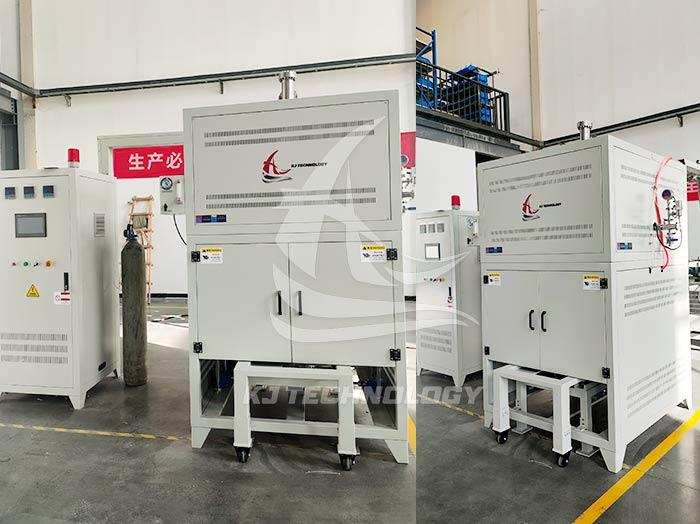The difference between nitrogen and argon in vacuum quenching furnace
 11-10-2025 Author: KJ technology
11-10-2025 Author: KJ technology
In vacuum gas quenching furnaces, nitrogen (N ₂) and argon (Ar) are commonly used quenching gases, which have significant differences in chemical properties, cooling capacity, cost, and application scenarios. Here is a detailed comparison between the two:
1. Chemical properties
Nitrogen (N ₂):
Chemical activity: Nitrogen is chemically stable at room temperature, but may react with certain metals (such as titanium, aluminum, magnesium, etc.) at high temperatures (usually>500 ℃) to form nitrides (such as TiN, AlN).
Potential impact: The generation of nitrides may alter the surface composition of materials, affecting hardness, wear resistance, or corrosion resistance. For example, if nitrogen is used during quenching of titanium alloys, a brittle titanium nitride layer may form, reducing fatigue life.
Argon (Ar):
Chemical inertness: Argon is a rare gas with extremely inert chemical properties, hardly reacting with any metals, and can remain stable even at high temperatures.
Advantages: Completely avoiding oxidation and nitriding issues, suitable for handling materials with extremely high surface purity requirements.
2. Cooling capacity
Nitrogen (N ₂):
Thermophysical properties: The thermal conductivity (0.026 W/m · K) and specific heat capacity (1.04 kJ/kg · K) of nitrogen are moderate, and the cooling rate is between argon and helium.
Cooling effect: Under the same pressure, nitrogen cools faster than argon but slower than helium. By increasing pressure or flow rate, the cooling effect can be further enhanced.
Argon (Ar):
Thermophysical properties: The thermal conductivity (0.018 W/m · K) and specific heat capacity (0.52 kJ/kg · K) of argon gas are relatively low, and its cooling capacity is weak.
Cooling effect: Under the same conditions, the cooling rate of argon gas is slower and needs to be compensated by increasing the pressure (such as to 6-10 bar) or flow rate, but the energy consumption and equipment requirements are higher.
3. Cost
Nitrogen (N ₂):
Source: Nitrogen is the most abundant gas in air (about 78%), which can be produced on a large scale through air separation equipment (such as cryogenic air separation or membrane separation) at an extremely low cost.
Economy: Suitable for large-scale production, especially in cost sensitive scenarios such as ordinary carbon steel and alloy steel quenching.
Argon (Ar):
Source: Argon is a rare gas that needs to be extracted through air separation equipment, and its content is relatively low (about 0.93%), resulting in high production costs.
Economy: The price is 5-10 times that of nitrogen, and it is only used when necessary (such as high-precision, high value-added parts).
4. Application scenarios
Applicable scenarios for nitrogen (N ₂):
Ordinary carbon steel and alloy steel: Nitrogen quenching can meet the hardness requirements and has low cost.
Materials insensitive to nitrides, such as some stainless steels and tool steels (such as H13, W6Mo5Cr4V2).
Batch production: such as automotive gears, bearings, etc., requires a balance between performance and cost.
Applicable scenarios for argon gas (Ar):
Titanium alloys and high-temperature alloys: avoid the formation of nitrides and maintain material purity (such as aerospace engine blades and turbine disks).
Active metals such as aluminum and magnesium prevent high-temperature oxidation and combustion.
Precision parts, such as medical devices (surgical instruments, implants) and electronic components, require strict control over surface quality.
Special processes such as vacuum brazing and vacuum sintering require an inert environment to avoid impurity contamination.
5. Comparison of typical cases
Case 1: Quenching of titanium alloy aviation parts
Nitrogen quenching: may form a titanium nitride layer, resulting in an increase in surface hardness but a decrease in toughness, and a shortened fatigue life.
Argon quenching: The surface is smooth and free of nitrides, the structure is uniform, and the fatigue life is improved.
Case 2: Quenching of Automotive Gears
Nitrogen quenching: Low cost, hardness meets the standard (58-62 HRC), and deformation can be controlled.
Argon quenching: High cost, but more uniform hardness distribution, suitable for high-end gears (such as racing gearboxes).
Case 3: Quenching of Aluminum Alloy Electronic Components
Nitrogen quenching: Aluminum alloys may react with nitrogen at high temperatures, causing surface oxidation and discoloration.
Argon quenching: The surface is bright, with no loss of conductivity, meeting high-precision requirements.
6. Suggestions for process optimization
Mixed gas usage:
Nitrogen argon mixture: By adjusting the ratio (such as 70% nitrogen+30% argon), the cooling rate and chemical inertness can be balanced, making it suitable for complex material systems (such as simultaneous processing of titanium alloys and stainless steel).
Cost optimization: Use nitrogen in non critical areas and argon in critical areas to reduce overall costs.
Process parameter adjustment:
Nitrogen quenching: By increasing pressure (such as to 4-6 bar) or flow rate, the cooling effect is enhanced, partially replacing argon gas.
Argon quenching: Optimize heating temperature and holding time, reduce dependence on high-speed cooling, and lower energy consumption.








